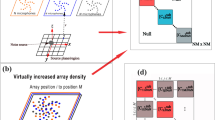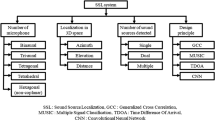Abstract
This research proposes an improved narrowband partial adaptive beamformer analysis using a proposed spherical array. Comparison between the fully and the partial adaptive beamformers is given. The study is performed by investigating performance parameters like the beamformer output signal-to-noise ratio and the beamformer output signal-to-interference-plus-noise ratio both in the steady state and along adaptation. Furthermore, computational complexity and convergence speed of the proposed sensor arrangement are also analyzed and examples are given. The results demonstrate that this beamformer considerably reduces the number of complex operations and features faster convergence speed.









Similar content being viewed by others
References
Abhayapala, T.D., & Ward, D. B. (2002). Theory and design of high order sound field microphones using spherical microphone array. In IEEE international conference on acoustics, speech, and signal processing (ICASSP) (Vol. 2, pp. 1949–1952).
Benesty, J., Chen, J., & Huang, Y. (2008). Microphone array signal processing (Vol. 1). Berlin: Springer Science & Business Media.
Brandstein, M., & Ward, D. (2001). Microphone arrays: Signal processing techniques and applications. Berlin: Springer Science & Business Media.
Burmeister, L. C. (1985). A Monte Carlo procedure for straight convecting boundaries. International Journal of Heat and Mass Transfer, 28(3), 717–720.
Capon, J. (1969). High-resolution frequency-wavenumber spectrum analysis. Proceedings of the IEEE, 57(8), 1408–1418.
Chapman, D. J. (1976). Partial adaptivity for the large array. IEEE Transactions on Antennas and Propagation, 24(5), 685–696.
Cioffi, J. M., & Kailath, T. (1984). Fast, recursive-least-squares transversal filters for adaptive filtering. IEEE Transactions on Acoustics, Speech and Signal Processing, 32(2), 304–337.
Collin, R. E., & Zucker, F. J. (1969). Antenna theory. New York: McGraw-Hill Book Co.
Dhiman, J., Ahmad, S., & Gulia, K. (2013). Comparison between adaptive filter algorithms (LMS, NLMS and RLS). International Journal of Science, Engineering and Technology Research, 2(5), 1100.
Duttweiler, D. L. (2000). Proportionate normalized least-mean-squares adaptation in echo cancelers. IEEE Transactions on Speech and Audio Processing, 8(5), 508–518.
Ehrenberg, L., Gannot, S., Leshem, A., & Zehavi, E. (2010). Sensitivity analysis of MVDR and MPDR beamformers. In IEEE 26th convention of electrical and electronics engineers in Israel (IEEEI) (pp. 000416–000420). IEEE.
Fuhrmann, D. R., Kelly, E. J., & Nitzberg, R. (1992). A Cfar adaptive matched filter detector. IEEE Transactions on Aerospace and Electronic Systems, 28(1), 208–216.
Gao, K., Ahmad, M. O., & Swamy, M. N. S. (1992). Learning algorithm for total least-squares adaptive signal processing. Electronics Letters, 28(4), 430–432.
Griffiths, J. W. R. (1983). Adaptive array processing. A tutorial. IEE Proceedings F Communications, Radar and Signal Processing, 130(1), 3.
Haykin, S., Justice, J. H., Owsley, N. L., Yen, J. L., & Kak, A. C. (1985). Array signal processing. Englewood Cliffs, NJ: Prentice-Hall, Inc.
Hudson, J. E. (1981). Adaptive array principles. Peregrinus: Institution of Electrical Engineers.
Ilyas, M. Z., Noor, A. O. A., Ishak, K. A., Hussain, A., & Samad, S. A. (2008). Normalized least mean square adaptive noise cancellation filtering for speaker verification in noisy environments. In International conference on electronic design. ICED. (pp. 1–4). IEEE.
Jablon, N. K. (1986). Adaptive beamforming with the generalized sidelobe canceller in the presence of array imperfections. IEEE Transactions on Antennas and Propagation, 34(8), 996–1012.
Johnson, D. H., & Dudgeon, D. E. (1993). Array signal processing: Concepts and techniques. Englewood Cliffs, NJ: Prentice Hall, Inc.
Krim, H., & Viberg, M. (1996). Two decades of array signal processing research: The parametric approach. IEEE Signal Processing Magazine, 13(4), 67–94.
Lambert, J. R., Balanis, C., DeCarl, D., et al. (2009). Spherical cap adaptive antennas for gps. IEEE Transactions on Antennas and Propagation, 57(2), 406–413.
Li, Y., Vicente, L. M., Ho, K. C., Kwan, C., Lun, D. P. K., & Leung, Y. H. (2008). A study of the partially adaptive concentric ring array. Circuits, Systems & Signal Processing, 27(5), 733–748.
Manolakis, D. G., Ingle, V. K., & Kogon, S. M. (2005). Statistical and adaptive signal processing: Spectral estimation, signal modeling, adaptive filtering, and array processing (Vol. 46). Norwood: Artech House.
Meyer, J., & Elko, G. (2002). A highly scalable spherical microphone array based on an orthonormal decomposition of the soundfield. In IEEE international conference on acoustics, speech, and signal processing (ICASSP), 2002 (Vol. 2, pp. 1781–1784). IEEE.
Nickel, U. (2006). Fundamentals of signal processing for phased array radar. Technical report, DTIC Document.
Owsley, N. L. (1985). Sonar array processing. In S. Haykin (Ed.), Array signal processing (pp. 115–193). Englewood Cliffs, NJ: Prentice Hall.
Piper, J. E. (2011). Beamforming narrowband and broadband signals, sonar systems. Prof. Nikolai Kolev, InTech.
Rafaely, B. (2005). Analysis and design of spherical microphone arrays. IEEE Transactions on Speech and Audio Processing, 13(1), 135–143.
Rafaely, B. (2008). Spatial sampling and beamforming for spherical microphone arrays. In Hands-free speech communication and microphone arrays, 2008. HSCMA 2008 (pp. 5–8). IEEE.
Rafaely, B. (2015). Fundamentals of spherical array processing. Springer Topics in Signal Processing (Vol. 8, pp. 101–123). Berlin, Heidelberg: Springer-Verlag.
Rafaely, B., Balmages, I., & Eger, L. (2007). High-resolution plane-wave decomposition in an auditorium using a dual-radius scanning spherical microphone array. The Journal of the Acoustical Society of America, 122(5), 2661–2668.
Rubinstein, R. Y., & Kroese, D. P. (2011). Simulation and the Monte Carlo method (Vol. 707). Amsterdam: Wiley.
Saff, E. B., & Kuijlaars, A. B. J. (1997). Distributing many points on a sphere. The Mathematical Intelligencer, 19(1), 5–11.
Van Trees, H. L. (2004). Detection, estimation, and modulation theory, optimum array processing. Amsterdam: Wiley.
Van Veen, B. D., Roberts, R., et al. (1987). Partially adaptive beamformer design via output power minimization. IEEE Transactions on Acoustics, Speech and Signal Processing, 35(11), 1524–1532.
Veen, B. V. (1988). Improved power minimization based partially adaptive beamformer design. In 1988 International Conference on Acoustics, Speech, and Signal Processing. ICASSP. (pp. 2793–2796). IEEE.
Wang, L. (2009). Array signal processing algorithms for beamforming and direction finding. Doctoral dissertation, University of York.
Widrow, B., & Stearns, S. D. (1985). Adaptive signal processing. Englewood Cliffs, NJ, Prentice-Hall Inc., 491 p. 1.
Xenaki, A., Jacobsen, F., Tiana-Roig, E., & Grande, E. F. (2010). Improving the resolution of beamforming measurements on wind turbines. In Proceedings of 20th international congress on acoustics, ICA, Sydney, Australia (pp. 23–27).
Yan, S., Sun, H., Svensson, U. P., Ma, X., & Hovem, J. M. (2011). Optimal modal beamforming for spherical microphone arrays. IEEE Transactions on Audio, Speech, and Language Processing, 19(2), 361–371.
Zatman, M. (1998). How narrow is narrowband? IEE Proceedings-Radar, Sonar and Navigation, 145(2), 85–91.
Acknowledgments
This work was sponsored by University of Castilla-La Mancha. Cuenca (Spain).
Author information
Authors and Affiliations
Corresponding author
Rights and permissions
About this article
Cite this article
Torres, A.M., Mateo, J. & Vicente, L.M. Performance analysis of narrowband beamforming using fully and partial adaptive beamformers with a spherical array. Multidim Syst Sign Process 28, 1325–1341 (2017). https://doi.org/10.1007/s11045-016-0398-z
Received:
Revised:
Accepted:
Published:
Issue Date:
DOI: https://doi.org/10.1007/s11045-016-0398-z




